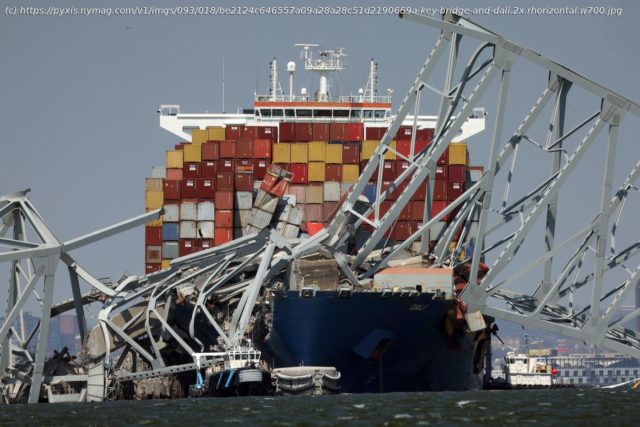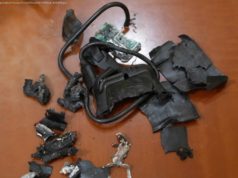Some of the most insightful commentary and analysis from engineers, maritime experts, political pundits, and locals on the collapse of Baltimore’s Francis Scott Key Bridge and what it means.
There are still as many questions as there are answers in aftermath of the catastrophic March 26 collision between the container ship Dali and Baltimore’s Francis Scott Key Bridge. Investigators continue to probe the disaster, which knocked out the busy Port of Baltimore, claimed the lives of six migrant workers who were still on the bridge when it collapsed, and has prompted concerns about how vulnerable America’s sea bridges are to the increasingly massive ships that pass under them. Meanwhile, the political response to the tragedy has gotten pretty ugly, including some baseless and racist attacks on Baltimore officials. Below is a roundup of some of the smartest commentary and analysis on the collapse and what it means from engineers, maritime experts, pundits, and others.
Here’s video of the collapse of the Francis Key Scott Bridge from this morning. The bridge was struck by a cargo ship just before 1:30 a.m. A search is underway for at least seven people. pic.twitter.com/FRGHeJ1gIe— The Baltimore Banner (@BaltimoreBanner) March 26, 2024
What engineers are saying about the disaster
In a post at the Conversation, Monash University civil engineering professor Colin Caprani explains what defenses the Francis Scott Key Bridge had in place to protect it in the event of a collision — and why they weren’t enough:
The bridge rests on four supports, two of which sit each side of the navigable waterway. It is these two piers that are critical to protect against ship impacts. And indeed, there were two layers of protection: a so-called “dolphin” structure made from concrete, and a fender. The dolphins are in the water about 100 metres upstream and downstream of the piers. They are intended to be sacrificed in the event of a wayward ship, absorbing its energy and being deformed in the process but keeping the ship from hitting the bridge itself.
The fender is the last layer of protection. It is a structure made of timber and reinforced concrete placed around the main piers. Again, it is intended to absorb the energy of any impact. Fenders are not intended to absorb impacts from very large vessels. And so when the MV Dali, weighing more than 100,000 tonnes, made it past the protective dolphins, it was simply far too massive for the fender to withstand.
Video recordings show a cloud of dust appearing just before the bridge collapsed, which may well have been the fender disintegrating as it was crushed by the ship. Once the massive ship had made it past both the dolphin and the fender, the pier – one of the bridge’s four main supports – was simply incapable of resisting the impact.
Satellite photos take after the collapse indicate that the Dali had indeed slipped past one of one of the four “dolphins” meant to protect the bridge pier.
At the New York Times, the Upshot’s Aatish Bhatia and Francesca Paris tried to determine the sheer force of the out of control container ship:
Our lowest estimate of how much force it would take to slow the Dali, if it were fully loaded, is around 12 million newtons, about a third of the force it took to launch the Saturn V rocket for the Apollo moon missions. And our higher-end estimates, reviewed by several civil engineering experts, suggest it is realistic to put the force of the impact with the pier at upward of 100 million newtons. “It’s at a scale of more energy than you can really get your mind around,” said Ben Schafer, a professor of civil and systems engineering at Johns Hopkins.
Experts disagreed on whether it was reasonable for any bridge pier to withstand a direct collision with a massive container ship. “Depending on the size of the container ship, the bridge doesn’t have any chance,” said Nii Attoh-Okine, a professor of engineering at the University of Maryland. He said that Baltimore’s Key Bridge had been performing perfectly before this accident occurred, and that he thought 95 to 99 percent of bridges would be damaged if such a container ship were to strike them. But Sherif El-Tawil, an engineering professor at the University of Michigan who reviewed our calculations, said it was feasible to design a pier that would stay standing after such an impact: “If this bridge had been designed to current standards, it would have survived.”
Modern bridges, designed in the age of ultralarge shipping containers, are typically built with stronger piers or protection systems around the piers that can either absorb or deflect the force of ship collisions. But the Key Bridge was completed in 1977, when standards were different and ships were far smaller.
Michael J. Chajes, a civil and environmental engineering professor at the University of Delaware, adds some historical context:
The Francis Scott Key Bridge was designed in the early 1970s. Construction started in 1972, and it opened to traffic in 1977. This preceded the 1980 collapse of the Sunshine Skyway in Florida, which was caused by a ship collision, similar to what happened in Baltimore. That bridge collapse led to the initiation of research projects that culminated in the development of a U.S. guide specification in 1991 that was updated in 2009. …
A pier protection system was installed when the Sunshine Skyway bridge was rebuilt, and it has been used on numerous other bridges. The same approach is currently being applied by the Delaware River and Bay Authority at a cost of US$93 million to protect the piers of the Delaware Memorial Bridge.
The reports that Maryland officials were at the time aware of the danger a ship collision like the one that took down the Sunshine Skyway Bridge posed to the Key Bridge — and that was a ship was just over a third the weight of the Dali:
At the time of the Sunshine Skyway Bridge accident, the Baltimore Sun reported that a top state engineer said the Key Bridge couldn’t withstand a similar collision. “I’m talking about the main supports, a direct hit — it would knock it down,” the official said.






